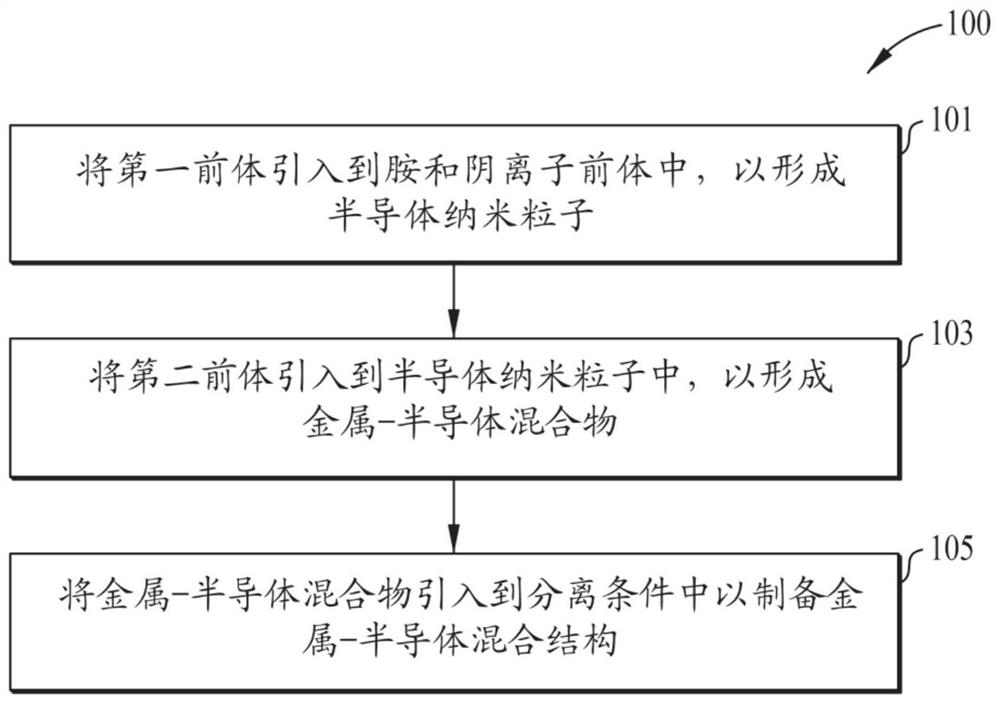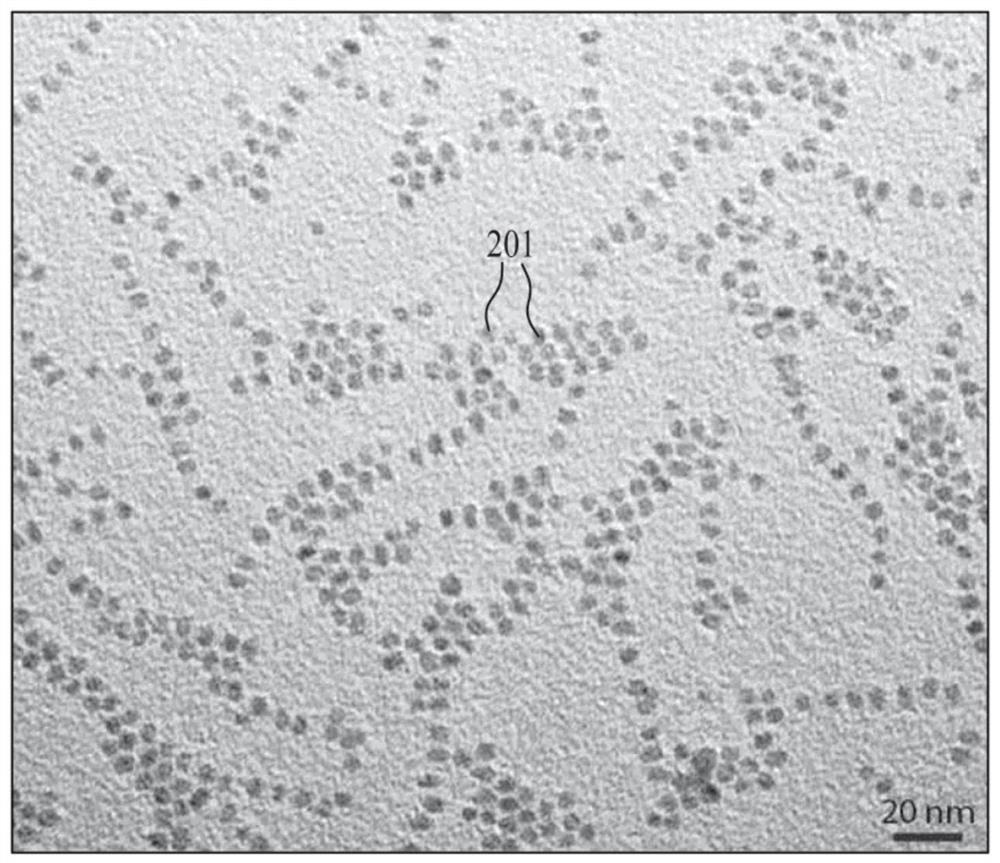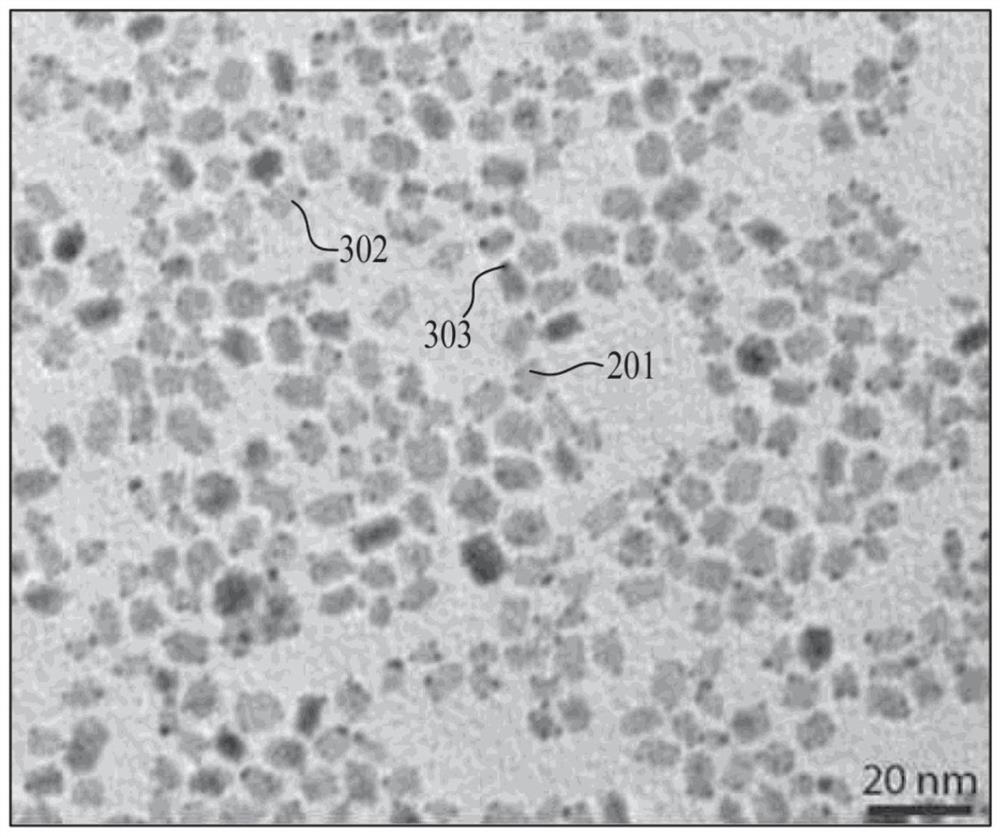Metal-semiconductor hybrid structures, syntheses thereof, and uses thereof
A hybrid structure, semiconductor technology, used in metal/metal oxide/metal hydroxide catalysts, preparation of organic compounds, preparation of aminohydroxy compounds, etc., can solve the problem of inability to control the size of metal nanoclusters
- Summary
- Abstract
- Description
- Claims
- Application Information
AI Technical Summary
Problems solved by technology
Method used
Image
Examples
preparation example Construction
[0049] figure 1 is an exemplary method 100 of fabricating a metal-semiconductor hybrid structure in accordance with at least one aspect. Exemplary method 100 can include at operation 101, under first conditions (eg, first reaction conditions), will comprise one or more elements (eg, metals) from Groups 11-14 of the Periodic Table of Elements A first precursor of is introduced into an amine and an anion precursor (e.g., a Group 15-Group 16 element such as sulfur) to form a semiconductor nanoparticles. Here, and as a non-limiting example, the semiconductor nanoparticles may be cadmium sulfide nanoparticles. Semiconductor nanoparticles may have one or more of those properties described above.
[0050] According to at least some aspects, the first precursor comprising one or more elements from Groups 11-14 of the Periodic Table may include Cu, Ag, Au, Zn, Cd, Hg, In, Pb, or combinations thereof combination. In some aspects, the first precursor may comprise a ligand, such as a...
Embodiment 1
[0076] Embodiment 1: the synthesis of cadmium sulfide nanoparticles
[0077] In argon (Ar) or N 2 186 mg cadmium acetylacetonate (0.6 mmol), 5.0 g TDA and 38.6 mg sulfur powder were added to the flask under flow. in Ar or N 2 After purging for 10 minutes, the mixed solution was heated to 220° C. and maintained at this temperature for 60 minutes. The reaction solution was then cooled to 100°C, and 5 mL of ethanol was added to the flask. The product was isolated by centrifugation at 5000 rpm for 5 minutes. After discarding the supernatant, 2.0 mL of hexane and 6.0 mL of ethanol were sequentially added to the precipitate, and the mixture was centrifuged at 5000 rpm for 5 min. The washing procedure was repeated twice to remove unreacted precursors and surfactants. Store cadmium sulfide in a hydrophobic solvent such as hexane, toluene, or chloroform.
Embodiment 2
[0078] Example 2: Growth of nanoclusters on cadmium sulfide surfaces
[0079] 2.0 g of TDA, 10 mL of toluene, and 10 mg of gold chloride trihydrate (0.025 mmol) were charged into a 25 mL three-necked flask deoxygenated for 10 minutes. Then 2.0 mL of cadmium sulfide solution (cadmium sulfide in toluene, 10 mg / mL) was injected into the flask under Ar flow. Alternatively, the cadmium sulfide solution may be a solution of cadmium sulfide in octadecene, phenyl ether and other solvents. After 20 minutes of argon flow, the flask was heated to 100°C. Argon flow helps to remove oxygen. The reaction was maintained at 100°C for 60 minutes, then the reaction solution was cooled to room temperature, and 5 mL of ethanol (or another hydrophilic solvent such as methanol and acetone) was added. The product was isolated by centrifugation at 5000 rpm for 5 minutes. After discarding the supernatant, 2.0 mL of hexane and 6.0 mL of ethanol were sequentially added to the precipitate, and the m...
PUM
| Property | Measurement | Unit |
|---|---|---|
| size | aaaaa | aaaaa |
| surface area | aaaaa | aaaaa |
| size | aaaaa | aaaaa |
Abstract
Description
Claims
Application Information
 Login to view more
Login to view more - R&D Engineer
- R&D Manager
- IP Professional
- Industry Leading Data Capabilities
- Powerful AI technology
- Patent DNA Extraction
Browse by: Latest US Patents, China's latest patents, Technical Efficacy Thesaurus, Application Domain, Technology Topic.
© 2024 PatSnap. All rights reserved.Legal|Privacy policy|Modern Slavery Act Transparency Statement|Sitemap



